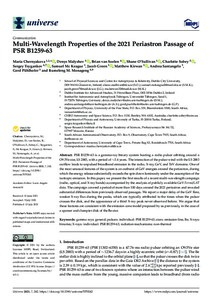Multi-Wavelength Properties of the 2021 Periastron Passage of PSR B1259-63
Chernyakova Maria; Malyshev Denys; van Soelen Brian; O'Sullivan Shane; Sobey Charlotte; Tsygankov Sergey; Mc Keague Samuel; Green Jacog; Kirwan Matthew; Santangelo Andrea; Puhlhofer Gerd; Monageng Itumeleng M
Multi-Wavelength Properties of the 2021 Periastron Passage of PSR B1259-63
Chernyakova Maria
Malyshev Denys
van Soelen Brian
O'Sullivan Shane
Sobey Charlotte
Tsygankov Sergey
Mc Keague Samuel
Green Jacog
Kirwan Matthew
Santangelo Andrea
Puhlhofer Gerd
Monageng Itumeleng M
MDPI
Julkaisun pysyvä osoite on:
https://urn.fi/URN:NBN:fi-fe2021093048964
https://urn.fi/URN:NBN:fi-fe2021093048964
Tiivistelmä
PSR B1259-63 is a gamma-ray binary system hosting a radio pulsar orbiting around a O9.5Ve star, LS 2883, with a period of similar to 3.4 years. The interaction of the pulsar wind with the LS 2883 outflow leads to unpulsed broadband emission in the radio, X-ray, GeV, and TeV domains. One of the most unusual features of the system is an outburst of GeV energies around the periastron, during which the energy release substantially exceeds the spin down luminosity under the assumption of the isotropic emission. In this paper, we present the first results of a recent multi-wavelength campaign (radio, optical, and X-ray bands) accompanied by the analysis of publicly available GeV Fermi/LAT data. The campaign covered a period of more than 100 days around the 2021 periastron and revealed substantial differences from previously observed passages. We report a major delay of the GeV flare, weaker X-ray flux during the peaks, which are typically attributed to the times when the pulsar crosses the disk, and the appearance of a third X-ray peak never observed before. We argue that these features are consistent with the emission cone model proposed by us previously, in the case of a sparser and clumpier disk of the Be star.
Kokoelmat
- Rinnakkaistallenteet [27094]
